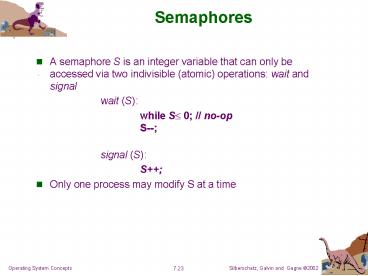Semaphores - PowerPoint PPT Presentation
1 / 8
Title:
Semaphores
Description:
... requires busy waiting. ... an integer value and a list of processes waiting on the semaphore ... are deadlocked since P0 waits for P1 to execute ... – PowerPoint PPT presentation
Number of Views:1970
Avg rating:3.0/5.0
Title: Semaphores
1
Semaphores
- A semaphore S is an integer variable that can
only be accessed via two indivisible (atomic)
operations wait and signal - wait (S)
- while S? 0 // no-op S--
- signal (S)
- S
- Only one process may modify S at a time
2
n-Process Critical Section Problem
- Shared data
- semaphore mutex // initially mutex 1
- Process Pi do wait(mutex)
critical section - signal(mutex) remainder section
while (1) - Satisfy mutual exclusion and progress
- Bounded waiting depend on semaphore
implementation
3
Semaphore as a General Synchronization Tool
- Two processes P1 and P2 , want P2 to execute S2
after P1 executes S1 - Let P1 and P2 share a common semaphore synch,
initialized to 0 - P1 P2
- S1 wait(synch)
- signal(synch) S2
4
Semaphore Implementation
- The semaphore definition requires busy waiting.
This type of semaphore is also called a spinlock. - Waste CPU cycles on uniprocessor systems
- Useful in multiprocessor systems when the process
only wait for a short period of time because no
context switch is required. - Solution let processes block themselves instead
of busy waiting - Put process in a waiting queue associated with
the semaphore - Switch the process state to waiting
- Transfer control to CPU scheduler
- When another process executes signal, restart a
process waiting on the semaphore
5
Semaphore Implementation
- Define a semaphore as a structure
- typedef struct
- int value struct process L
semaphore - Each semaphore has an integer value and a list of
processes waiting on the semaphore - Assume two operations
- block() change the process that invokes it to
waiting state - wakeup(P) change process P from waiting state to
ready state and put it in the ready queue.
6
Semaphore Implementation
- Semaphore operations now defined as
- wait(S) S.value--
- if (S.value lt 0)
- add this process to S.L
block() // process changed to waiting state - signal(S) S.value
- if (S.value lt 0)
- remove a process P from S.L
wakeup(P) // process P changed to ready state - When semaphore value is negative, its magnitude
is the number of processes waiting on the
semaphore - To ensure bounded waiting, implement the list of
waiting processes as a FIFO queue
7
Implementation Issues
- Wait and signal must be atomic no two processes
can execute wait and signal on the same semaphore
at the same time a critical-section problem! - Two solutions
- 1. Inhibit interrupts during the wait and signal
operations (only work for uniprocessor systems) - 2. Use software solutions for the
critical-section problem (e.g. bakery algorithm)
where the critical sections consist of the wait
and signal procedures - Still have busy waiting, but time spent in
critical section (i.e., executing signal/wait)
will be short
8
Deadlock and Starvation
- Deadlock two or more processes are waiting
indefinitely for an event that can be caused by
only one of the waiting processes. - An example
- Let S and Q be two semaphores initialized
to 1 - P0 P1
- wait(S) wait(Q)
- wait(Q) wait(S)
- ? ?
- signal(S) signal(Q)
- signal(Q) signal(S)
- P0 and P1 are deadlocked since P0 waits for P1 to
execute signal(Q) - and P1 waits for P0 to execute signal(S)
- Starvation or indefinite blocking a process may
wait indefinitely in a semaphore queue.































